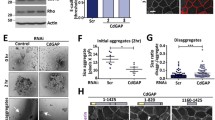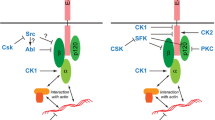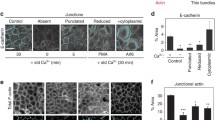Abstract
Tight junctions (TJ) and adherens junctions (AJ) are key morphological features of differentiated epithelial cells that regulate the integrity and permeability of tissue barriers. Structure and remodeling of epithelial junctions depends on their association with the underlying actomyosin cytoskeleton. Anillin is a unique scaffolding protein interacting with different cytoskeletal components, including actin filaments and myosin motors. Its role in the regulation of mammalian epithelial junctions remains unexplored. Downregulation of anillin expression in human prostate, colonic, and lung epithelial cells triggered AJ and TJ disassembly without altering the expression of junctional proteins. This junctional disassembly was accompanied by dramatic disorganization of the perijunctional actomyosin belt; while the general architecture of the actin cytoskeleton, and activation status of non-muscle myosin II, remained unchanged. Furthermore, loss of anillin disrupted the adducin–spectrin membrane skeleton at the areas of cell–cell contact, selectively decreased γ-adducin expression, and induced cytoplasmic aggregation of αII-spectrin. Anillin knockdown activated c-Jun N-terminal kinase (JNK), and JNK inhibition restored AJ and TJ integrity and cytoskeletal organization in anillin-depleted cells. These findings suggest a novel role for anillin in regulating intercellular adhesion in model human epithelia by mechanisms involving the suppression of JNK activity and controlling the assembly of the perijunctional cytoskeleton.









Similar content being viewed by others
References
Anderson JM, Van Itallie CM (2009) Physiology and function of the tight junction. Cold Spring Harb Perspect Biol 1:a002584
Cheng CY, Mruk DD (2012) The blood-testis barrier and its implications for male contraception. Pharmacol Rev 64:16–64
Turner JR (2009) Intestinal mucosal barrier function in health and disease. Nat Rev Immunol 9:799–809
Green KJ, Getsios S, Troyanovsky S, Godsel L (2010) Intercellular junction assembly, dynamics, and homeostasis. Cold Spring Harb Perspect Biol 2:a000125
Tsukita S, Furuse M, Itoh M (2001) Multifunctional strands in tight junctions. Nat Rev Mol Cell Biol 2:285–293
Furuse M (2010) Molecular basis of the core structure of tight junctions. Cold Spring Harb Perspect Biol 2:a002907
Furuse M, Izumi Y, Oda Y, Higashi T, Iwamoto N (2014) Molecular organization of tricellular tight junctions. Tissue barriers 2:e28960
Meng W, Takeichi M (2009) Adherens junction: molecular architecture and regulation. Cold Spring Harb Perspect Biol 1:a002899
Troyanovsky S (2012) Adherens junction assembly. Subcell Biochem 60:89–108
Van Itallie CM, Anderson JM (2013) Claudin interactions in and out of the tight junction. Tissue barriers 1:e25247
Han SP, Yap AS (2012) The cytoskeleton and classical cadherin adhesions. Subcell Biochem 60:111–135
Ivanov AI (2008) Actin motors that drive formation and disassembly of epithelial apical junctions. Front Biosci 13:6662–6681
Ivanov AI, Naydenov NG (2013) Dynamics and regulation of epithelial adherens junctions: recent discoveries and controversies. Int Rev Cell Mol Biol 303:27–99
Shen L, Weber CR, Raleigh DR, Yu D, Turner JR (2011) Tight junction pore and leak pathways: a dynamic duo. Annu Rev Physiol 73:283–309
Troyanovsky SM (2008) Regulation of cadherin-based epithelial cell adhesion by endocytosis. Front Biosci Scholar Ed 1:61–67
Hirokawa N, Heuser JE (1981) Quick-freeze, deep-etch visualization of the cytoskeleton beneath surface differentiations of intestinal epithelial cells. J Cell Biol 91:399–409
Hirokawa N, Tilney LG (1982) Interactions between actin filaments and between actin filaments and membranes in quick-frozen and deeply etched hair cells of the chick ear. J Cell Biol 95:249–261
Madara JL (1987) Intestinal absorptive cell tight junctions are linked to cytoskeleton. Am J Physiol 253:C171–C175
Ivanov AI, Parkos CA, Nusrat A (2010) Cytoskeletal regulation of epithelial barrier function during inflammation. Am J Pathol 177:512–524
Yonemura S (2011) Cadherin–actin interactions at adherens junctions. Curr Opin Cell Biol 23:515–522
Takeichi M (2014) Dynamic contacts: rearranging adherens junctions to drive epithelial remodelling. Nat Rev Mol Cell Biol 15:397–410
Dominguez R, Holmes KC (2011) Actin structure and function. Annu Rev Biophys 40:169
Dos Remedios C, Chhabra D, Kekic M, Dedova I, Tsubakihara M, Berry D, Nosworthy N (2003) Actin binding proteins: regulation of cytoskeletal microfilaments. Physiol Rev 83:433–473
Citalán-Madrid AF, García-Ponce A, Vargas-Robles H, Betanzos A, Schnoor M (2013) Small GTPases of the Ras superfamily regulate intestinal epithelial homeostasis and barrier function via common and unique mechanisms. Tissue barriers 1:e26938
McCole DF (2013) Phosphatase regulation of intercellular junctions. Tissue barriers 1:e26713
Vicente-Manzanares M, Ma X, Adelstein RS, Horwitz AR (2009) Non-muscle myosin II takes centre stage in cell adhesion and migration. Nat Rev Mol Cell Biol 10:778–790
D’Avino PP (2009) How to scaffold the contractile ring for a safe cytokinesis–lessons from Anillin-related proteins. J Cell Sci 122:1071–1079
Hickson GR, O’Farrell PH (2008) Anillin: a pivotal organizer of the cytokinetic machinery. Biochem Soc Trans 36:439
Piekny AJ, Maddox AS (2010) The myriad roles of Anillin during cytokinesis. Semin Cell Dev Biol 21:881–891
Field CM, Alberts BM (1995) Anillin, a contractile ring protein that cycles from the nucleus to the cell cortex. J Cell Biol 131:165–178
Kinoshita M, Field CM, Coughlin ML, Straight AF, Mitchison TJ (2002) Self-and actin-templated assembly of mammalian septins. Dev Cell 3:791–802
Field CM, Coughlin M, Doberstein S, Marty T, Sullivan W (2005) Characterization of anillin mutants reveals essential roles in septin localization and plasma membrane integrity. Development 132:2849–2860
Piekny AJ, Glotzer M (2008) Anillin is a scaffold protein that links RhoA, actin, and myosin during cytokinesis. Curr Biol 18:30–36
Straight AF, Field CM, Mitchison TJ (2005) Anillin binds nonmuscle myosin II and regulates the contractile ring. Mol Biol Cell 16:193–201
Suzuki C, Daigo Y, Ishikawa N, Kato T, Hayama S, Ito T, Tsuchiya E, Nakamura Y (2005) ANLN plays a critical role in human lung carcinogenesis through the activation of RHOA and by involvement in the phosphoinositide 3-kinase/AKT pathway. Cancer Res 65:11314–11325
Dorn JF, Zhang L, Paradis V, Edoh-Bedi D, Jusu S, Maddox PS, Maddox AS (2010) Actomyosin tube formation in polar body cytokinesis requires anillin in C. elegans. Curr Biol 20:2046–2051
Gbadegesin RA, Hall G, Adeyemo A, Hanke N, Tossidou I, Burchette J, Wu G, Homstad A, Sparks MA, Gomez J, Jiang R, Alonso A, Lavin P, Conlon P, Korstanje R, Stander MC, Shamsan G, Barua M, Spurney R, Singhal PC, Kopp JB, Haller H, Howell D, Pollak MR, Shaw AS, Schiffer M, Winn MP (2014) Mutations in the gene that encodes the F-actin binding protein anillin cause FSGS. J Am Soc Nephrol 25:1991–2002
Toret CP, D’Ambrosio MV, Vale RD, Simon MA, Nelson WJ (2014) A genome-wide screen identifies conserved protein hubs required for cadherin-mediated cell–cell adhesion. J Cell Biol 204:265–279
Reyes CC, Jin M, Breznau EB, Espino R, Delgado-Gonzalo R, Goryachev AB, Miller AL (2014) Anillin regulates cell-cell junction integrity by organizing junctional accumulation of Rho-GTP and actomyosin. Curr Biol 24:1263–1270
Liu Y, Nusrat A, Schnell FJ, Reaves TA, Walsh S, Pochet M, Parkos CA (2000) Human junction adhesion molecule regulates tight junction resealing in epithelia. J Cell Sci 113(Pt 13):2363–2374
Baranwal S, Naydenov NG, Harris G, Dugina V, Morgan KG, Chaponnier C, Ivanov AI (2012) Nonredundant roles of cytoplasmic beta- and gamma-actin isoforms in regulation of epithelial apical junctions. Mol Biol Cell 23:3542–3553
Naydenov NG, Baranwal S, Khan S, Feygin A, Gupta P, Ivanov AI (2013) Novel mechanism of cytokine-induced disruption of epithelial barriers: janus kinase and protein kinase D-dependent downregulation of junction protein expression. Tissue Barriers 1:e25231
Lou H, Park JJ, Phillips A, Loh YP (2013) gamma-Adducin promotes process outgrowth and secretory protein exit from the Golgi apparatus. J Mol Neurosci 49:1–10
Chen HC (2005) Cell-scatter assay. Methods Mol Biol 294:69–77
Echard A, Hickson GR, Foley E, O’Farrell PH (2004) Terminal cytokinesis events uncovered after an RNAi screen. Curr Biol 14:1685–1693
Elbediwy A, Zihni C, Terry SJ, Clark P, Matter K, Balda MS (2012) Epithelial junction formation requires confinement of Cdc42 activity by a novel SH3BP1 complex. J Cell Biol 198:677–693
Guillemot L, Guerrera D, Spadaro D, Tapia R, Jond L, Citi S (2014) MgcRacGAP interacts with cingulin and paracingulin to regulate Rac1 activation and development of the tight junction barrier during epithelial junction assembly. Mol Biol Cell 25:1995–2005
Priya R, Yap AS, Gomez GA (2013) E-cadherin supports steady-state Rho signaling at the epithelial zonula adherens. Differentiation 86:133–140
Ratheesh A, Gomez GA, Priya R, Verma S, Kovacs EM, Jiang K, Brown NH, Akhmanova A, Stehbens SJ, Yap AS (2012) Centralspindlin and alpha-catenin regulate Rho signalling at the epithelial zonula adherens. Nat Cell Biol 14:818–828
Tang VW, Brieher WM (2013) FSGS3/CD2AP is a barbed-end capping protein that stabilizes actin and strengthens adherens junctions. J Cell Biol 203:815–833
Bennett V, Baines AJ (2001) Spectrin and ankyrin-based pathways: metazoan inventions for integrating cells into tissues. Physiol Rev 81:1353–1392
Fowler VM (2012) The human erythrocyte plasma membrane: a rosetta stone for decoding membrane-cytoskeleton structure. Curr Top Membr 72:39–88
Naydenov NG, Ivanov AI (2010) Adducins regulate remodeling of apical junctions in human epithelial cells. Mol Biol Cell 21:3506–3517
Abdi KM, Bennett V (2008) Adducin promotes micrometer-scale organization of β2-spectrin in lateral membranes of bronchial epithelial cells. Mol Biol Cell 19:536–545
Kizhatil K, Davis JQ, Davis L, Hoffman J, Hogan BL, Bennett V (2007) Ankyrin-G is a molecular partner of E-cadherin in epithelial cells and early embryos. J Biol Chem 282:26552–26561
Kizhatil K, Yoon W, Mohler PJ, Davis LH, Hoffman JA, Bennett V (2007) Ankyrin-G and β2-spectrin collaborate in biogenesis of lateral membrane of human bronchial epithelial cells. J Biol Chem 282:2029–2037
Kevil CG, Oshima T, Alexander JS (2001) The role of p38 MAP kinase in hydrogen peroxide mediated endothelial solute permeability. Endothelium 8:107–116
Kojima T, Yamaguchi H, Ito T, Kyuno D, Kono T, Konno T, Sawada N (2013) Tight junctions in human pancreatic duct epithelial cells. Tissue barriers 1:e24894
Naydenov NG, Hopkins AM, Ivanov AI (2009) c-Jun N-terminal kinase mediates disassembly of apical junctions in model intestinal epithelia. Cell Cycle 8:2110–2121
Samak G, Aggarwal S, Rao RK (2011) ERK is involved in EGF-mediated protection of tight junctions, but not adherens junctions, in acetaldehyde-treated Caco-2 cell monolayers. Am J Physiol Gastrointest Liver Physiol 301:G50–G59
Spindler V, Rotzer V, Dehner C, Kempf B, Gliem M, Radeva M, Hartlieb E, Harms GS, Schmidt E, Waschke J (2013) Peptide-mediated desmoglein 3 crosslinking prevents pemphigus vulgaris autoantibody-induced skin blistering. J Clin Invest 123:800–811
You H, Lei P, Andreadis ST (2013) JNK is a novel regulator of intercellular adhesion. Tissue Barriers 1:e26845
Bennett BL, Sasaki DT, Murray BW, O’Leary EC, Sakata ST, Xu W, Leisten JC, Motiwala A, Pierce S, Satoh Y, Bhagwat SS, Manning AM, Anderson DW (2001) SP600125, an anthrapyrazolone inhibitor of Jun N-terminal kinase. Proc Natl Acad Sci U S A 98:13681–13686
Hall PA, Todd CB, Hyland PL, McDade SS, Grabsch H, Hillan KJ, Russell SH (2005) The septin-binding protein anillin is overexpressed in diverse human tumors. Clin Cancer Res 11:6780–6786
D’Avino PP, Takeda T, Capalbo L, Zhang W, Lilley KS, Laue ED, Glover DM (2008) Interaction between Anillin and RacGAP50C connects the actomyosin contractile ring with spindle microtubules at the cell division site. J Cell Sci 121:1151–1158
Frenette P, Haines E, Loloyan M, Kinal M, Pakarian P, Piekny A (2012) An anillin-Ect2 complex stabilizes central spindle microtubules at the cortex during cytokinesis. PLoS One 7:e34888
Gregory SL, Ebrahimi S, Milverton J, Jones WM, Bejsovec A, Saint R (2008) Cell division requires a direct link between microtubule-bound RacGAP and Anillin in the contractile ring. Curr Biol 18:25–29
Xia W, Mruk DD, Lee WM, Cheng CY (2006) Differential interactions between transforming growth factor-beta3/TbetaR1, TAB 1, and CD2AP disrupt blood-testis barrier and Sertoli-germ cell adhesion. J Biol Chem 281:16799–16813
Bennett V, Healy J (2009) Membrane domains based on ankyrin and spectrin associated with cell–cell interactions. Cold Spring Harb Perspect Biol 1:a003012
Naydenov NG, Ivanov AI (2011) Spectrin-adducin membrane skeleton: a missing link between epithelial junctions and the actin cytoskeletion? Bioarchitecture 1:186–191
Matsuoka Y, Li X, Bennett V (2000) Adducin: structure, function and regulation. Cell Mol Life Sci 57:884–895
Olson EN, Nordheim A (2010) Linking actin dynamics and gene transcription to drive cellular motile functions. Nat Rev Mol Cell Biol 11:353–365
Zheng B, Han M, Bernier M, Wen JK (2009) Nuclear actin and actin-binding proteins in the regulation of transcription and gene expression. FEBS J 276:2669–2685
Chen CL, Lin YP, Lai YC, Chen HC (2011) α-Adducin translocates to the nucleus upon loss of cell–cell adhesions. Traffic 12:1327–1340
Miyauchi JT, Piermarini PM, Yang JD, Gilligan DM, Beyenbach KW (2013) Roles of PKC and phospho-adducin in transepithelial fluid secretion by Malpighian tubules of the yellow fever mosquito. Tissue Barriers 1:e23120
Rötzer V, Breit A, Waschke J, Spindler V (2014) Adducin is required for desmosomal cohesion in keratinocytes. J Biol Chem 289:14925–14940
Konno T, Ninomiya T, Kohno T, Kikuchi S, Sawada N, Kojima T (2014) c-Jun N-terminal kinase inhibitor SP600125 enhances barrier function and elongation of human pancreatic cancer cell line HPAC in a Ca-switch model. Histochem Cell Biol 16:16
Lee MH, Koria P, Qu J, Andreadis ST (2009) JNK phosphorylates beta-catenin and regulates adherens junctions. FASEB J 23:3874–3883
Lee MH, Padmashali R, Koria P, Andreadis ST (2011) JNK regulates binding of alpha-catenin to adherens junctions and cell-cell adhesion. FASEB J 25:613–623
Samak G, Chaudhry KK, Gangwar R, Narayanan D, Jaggar JH, Rao R (2015) Calcium/Ask1/MKK7/JNK2/c-Src signalling cascade mediates disruption of intestinal epithelial tight junctions by dextran sulfate sodium. Biochem J 465:503–515
Al-Sadi R, Ye D, Boivin M, Guo S, Hashimi M, Ereifej L, Ma TY (2014) Interleukin-6 modulation of intestinal epithelial tight junction permeability is mediated by JNK pathway activation of claudin-2 gene. PLoS One 9:e85345
Carrozzino F, Pugnale P, Feraille E, Montesano R (2009) Inhibition of basal p38 or JNK activity enhances epithelial barrier function through differential modulation of claudin expression. Am J Physiol Cell Physiol 297:C775–C787
Kulshammer E, Uhlirova M (2013) The actin cross-linker Filamin/Cheerio mediates tumor malignancy downstream of JNK signaling. J Cell Sci 126:927–938
Ma PC, Tretiakova MS, Nallasura V, Jagadeeswaran R, Husain AN, Salgia R (2007) Downstream signalling and specific inhibition of c-MET/HGF pathway in small cell lung cancer: implications for tumour invasion. Br J Cancer 97:368–377
Ursitti JA, Petrich BG, Lee PC, Resneck WG, Ye X, Yang J, Randall WR, Bloch RJ, Wang Y (2007) Role of an alternatively spliced form of alphaII-spectrin in localization of connexin 43 in cardiomyocytes and regulation by stress-activated protein kinase. J Mol Cell Cardiol 42:572–581
Smith TC, Fridy PC, Li Y, Basil S, Arjun S, Friesen RM, Leszyk J, Chait BT, Rout MP, Luna EJ (2013) Supervillin binding to myosin II and synergism with anillin are required for cytokinesis. Mol Biol Cell 24:3603–3619
Acknowledgments
We thank Drs. Charles A. Parkos, Y. Peng Loh, Enrique Rodriguez-Boulan, and Andrei Budanov for providing reagents for this study. Microscopy was performed at the VCU Department of Anatomy and Neurobiology Microscopy Facility, supported, in part, with funding from the NIH-NINDS Center core grant 5P30NS047463. This work was supported by National Institute of Health grants RO1 DK083968 and DK084953 to A.I.I.
Conflict of interests
The authors declared no conflict of interests.
Author information
Authors and Affiliations
Corresponding author
Additional information
D. Wang and G. K. Chadha contributed equally to the paper.
Electronic supplementary material
Below is the link to the electronic supplementary material.
Rights and permissions
About this article
Cite this article
Wang, D., Chadha, G.K., Feygin, A. et al. F-actin binding protein, anillin, regulates integrity of intercellular junctions in human epithelial cells. Cell. Mol. Life Sci. 72, 3185–3200 (2015). https://doi.org/10.1007/s00018-015-1890-6
Received:
Revised:
Accepted:
Published:
Issue Date:
DOI: https://doi.org/10.1007/s00018-015-1890-6




